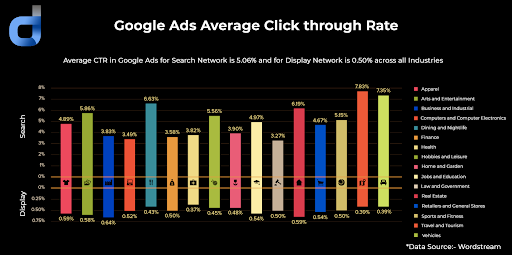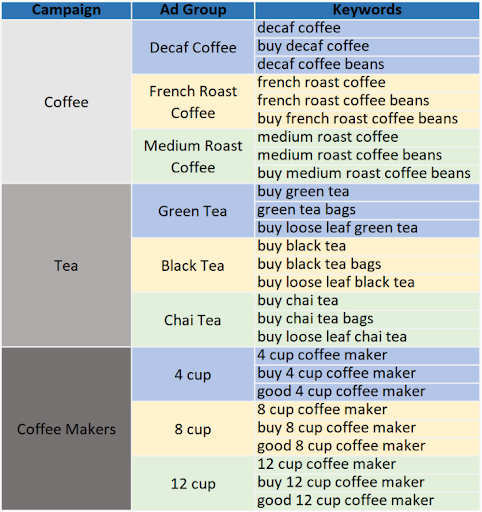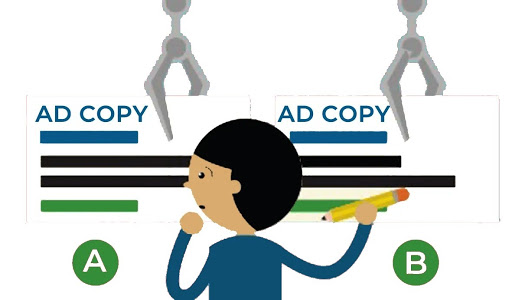Google Ads is probably one of the best ways to get your product or service in front of the right people with the right message and at the right time. But when it comes to the effective running of ads, there are tons of factors in Google Ads, which would help you achieve your goals.
All of your high performing campaigns have some common attributes that can be used to predict your ongoing or next to one’s success. A High Click Through Rate(CTR) is one of the largest contributors in judging it. Not only it increases your Goal conversion, but it is indirectly responsible for decreasing your overall CPC and a direct factor in deciding the Quality Score of your Ad.
Keeping an average good CTR is no rocket science, and yet many marketers struggle in doing so. In this blog, we will be covering the Top 5 Practices to Improve Google Ads CTR, which makes your campaign more successful.
What actually is a Good Google Ads CTR?
Now comes the point that we should actually know where we are going before knowing the direction to any place. What actually is termed as good CTR in Google Ads? It actually depends and varies from industry to industry. See the Figure below to know Average CTR for various industries.

Source:- Dicorn Digital
We can observe that, on average, we have about 5% CTR for Search Ads and 0.5% for Google Display Network Ads. Before checking your CTR for Search Ads, make sure you have selected only Google Search. This is because if your Ads are running on Search Partners, you may see an overall lower CTR. You can do this by going to Segment-> Network(with Search Partners).
Don’tDon’t worry about Search Partners as we can’t optimize for them in any way. You can remove them if they are making your Cost per Conversion higher than Average.
Here we come to the main part, Top 5 Practices to Improve Google Ads CTR.
#1 Organize your Campaigns and Ad Groups
You definitely don’t want Ad groups with tons of Irrelevant keywords in them, which decreases your efficiency to look at data properly and further decreases the scope of finding Improvement opportunities.
Create your Ad groups by themes of your website. You can take the help of your Navigational structure to get an idea of how you want to structure your Account in the form of Campaigns and Ad Groups in PPC campaign.
Make sure all your Keywords, Ads, and Landing pages are matching up. This means that your Landing pages should reflect the type of keywords you are trying to target with your advertisements. If you have 1 or 2 landing pages for an entire campaign, you need to create more relevant ones.
This would help you in a better conversion and goal completion and improve your expected CTR, which increases your overall Quality Score and hence better Adpositions in SERPs.

#2 Using Phrase Match Keywords and Negative Keywords
It is a great practice to start with creating new campaigns and improve Google Ads CTR. As we know, Negative keywords tell Google which keywords you don’t want your Ads to appear even if any other match types tells it to do so. This ensures that your Ads are not shown in places where there is a low or no probability of your ads to be clicked.
This included branded keywords or keywords that you don’t offer products or services on. Ex:- You sell TV stands, and your prospective customer types search term as “TV Stands Amazon.” This specifically means that they are more interested in buying or viewing from amazon rather than you.

You can get this data by going to the Search Terms report and seeing which keywords drive low Click through rates and observe if you need a negative keyword for them.
When you create a new campaign or ad group, make sure you start with either Broad Match Modifier keywords or Phrase match to expand your Impression data. You can later shift to Exact Match after knowing which keywords you are getting a conversion.
Make sure to note that you should rarely start with Broad Match keywords until and unless you are an advertiser with an unlimited budget. This would hurt your CTR in my experience.
Source:- Surfside PPC
#3 Use all Ad Types and Relevant Ad Extensions
While setting up, try to use all Ad types until and unless you know which ones are working best for you. Let’sLet’s say you are selling Curtains. So while setting up an Ad group for a particular Ad type, say Responsive Search Ads, duplicate the same Ad group for Expanded Search Ads.
If you want, you can try out duplicating again and test out different landing pages. Over time as you get more and more data, the ads that will perform the best will serve the most on Search Engine. Observe which ones are performing the best, and in the future, either delete the low-performing ones or A/B test more things on them.
Another thing to do is to use Ad group level Extensions. Some of the most common and very important Extensions are Sitelinks, Callout, Structured extensions, etc. Ad Extensions matter because they Increase your engagement by covering more space and offering more information to users, hence better CTRs.
It also increases your Ad Quality, hence a better Ad Rank. Ensure you are using only relevant ones and not all in bulk. 4 Ad extensions are recommended as per experience.
Let’sLet’s say you have an online shop, then using Physical Extensions makes no sense to you, and on the other side, it would make perfect sense for a business that has a physical shop.
DO YOU KNOW:- As per Google, using Callout extensions can increase average CTR by about 10%!!. Callout extensions are Short, specific, and value-adding attributes. Make sure your Extensions are Appealing and concrete.
#4 Test new Offers, Ad Copy, and consider Competitor Ads
When you plan to bid on certain keywords, do a quick search, and see what your competitors are having in their Ad copy. If you have some paid tools like Ahrefs, you can directly see most of their bidding ads and Ad copies via the Site Explorer tool.
Try to see ads that are always at top results vs. those at the bottom and see what’s missing or added. This would almost perfect your Ad Copy and hence give you a better CTR.
Over time what you should also do is go to your own Ads and see which of your Ads are not performing and only consuming your budget. You can pause those Ads or change their Offers or Landing pages inspired by the ones that perform better.

People often feel that an Ad is created perfectly for the very first time. But this is rarely this case. Ads are constantly improved by A/B testing different Landing Pages, Ad Copy, Ad Extensions, and all possible things which make an Ad Group. Even if a good performing ad is created, there is always room for improvements. Hence, testing and testing is the biggest formula for success in Google Ads or even any Advertisements.
#5 Find Low Performing CTR keywords.
By coming to the Campaign level, see all your search keywords and see the expected Click through rate sorted by worst to best. See the keywords that have an average or below-average CTR. Go to their Respective Ad groups and see why the Ads are not performing well.
The most common reasons may be Wrong Ad type, wrong landing page, wrong Ad copy, or even the keyword you chose is not up to the mark or relevant to the brand. Such keywords should be removed as you can do anything for them. For other cases, try different things and see that would work.
Just remember, not every ad will be a winner; in fact, many of your ads won’t be winners. The simplest solution would be to pause them and focus your bids on those who are winners.
Conclusion
At last, the final suggestion I can give is that nothing in the world happens overnight. After making your changes, wait, and see if the change is working. If it’s not, try a different thing. It would take a lot of trial and error to get to the perfect place to get the best ROI of the budget you allotted to Google Ads.
Not all of these techniques will work for everyone. Few may get benefits from some of them, while the performing factors may be different for others. It is all about trying new things.
I hope you get better results from these Top 5 Practices to Improve Google Ads CTR, and please share which one worked the best for you !!!







1 Comment